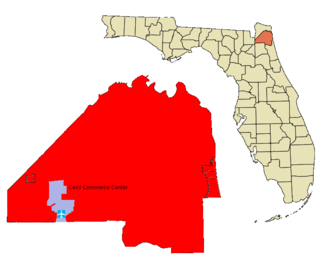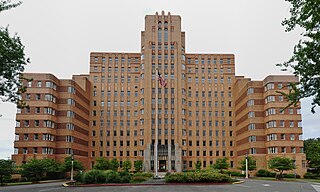Lawrence Livermore National Laboratory (LLNL) is a federally funded research and development center in Livermore, California, United States. Originally established in 1952, the laboratory now is sponsored by the United States Department of Energy and administered privately by Lawrence Livermore National Security, LLC.

The United States Department of Energy (DOE) is an executive department of the U.S. federal government that oversees U.S. national energy policy and energy production, as well as manages the research and development of nuclear power, the military's nuclear weapons program, nuclear reactor production for the United States Navy, energy-related research, and energy conservation.

Honeywell International Inc. is an American publicly traded, multinational conglomerate corporation headquartered in Charlotte, North Carolina. It primarily operates in four areas of business: aerospace, building automation, performance materials and technologies (PMT), and safety and productivity solutions (SPS). Honeywell is a Fortune 500 company, ranked 115th in 2023. In 2022, the corporation had a global workforce of approximately 97,000 employees, down from 113,000 in 2019. The current chairman is Darius Adamczyk and the chief executive officer (CEO) is Vimal Kapur.
The Laboratory for Laser Energetics (LLE) is a scientific research facility which is part of the University of Rochester's south campus, located in Brighton, New York. The lab was established in 1970 with operations jointly funded by the United States Department of Energy, the University of Rochester and the New York State government. The Laser Lab was commissioned to investigate high-energy physics involving the interaction of extremely intense laser radiation with matter. Scientific experiments at the facility emphasize inertial confinement, direct drive, laser-induced fusion, fundamental plasma physics and astrophysics using the Omega Laser Facility. In June 1995, OMEGA became the world's highest-energy ultraviolet laser. The lab shares its building with the Center for Optoelectronics and Imaging and the Center for Optics Manufacturing. The Robert L. Sproull Center for Ultra High Intensity Laser Research was opened in 2005 and houses the OMEGA EP laser, which was completed in May 2008.

The Savannah River Site (SRS) is a U.S. Department of Energy (DOE) reservation in the United States, located in the state of South Carolina on land in Aiken, Allendale, and Barnwell counties adjacent to the Savannah River. It lies 25 miles (40 km) southeast of Augusta, Georgia. The site was built during the 1950s to refine nuclear materials for deployment in nuclear weapons. It covers 310 square miles (800 km2) and employs more than 10,000 people.

Bendix Corporation is an American manufacturing and engineering company which, during various times in its existence, made automotive brake shoes and systems, vacuum tubes, aircraft brakes, aeronautical hydraulics and electric power systems, avionics, aircraft and automobile fuel control systems, radios, televisions and computers.
The Reliable Replacement Warhead (RRW) was a proposed new American nuclear warhead design and bomb family that was intended to be simple, reliable and to provide a long-lasting, low-maintenance future nuclear force for the United States. Initiated by the United States Congress in 2004, it became a centerpiece of the plans of the National Nuclear Security Administration (NNSA) to remake the nuclear weapons complex.

Fort Chaffee Joint Maneuver Training Center, also known as Fort Chaffee, is an Arkansas Army National Guard installation located in western Arkansas, adjacent to the city of Fort Smith. Established as Camp Chaffee in 1941, renamed to Fort Chaffee in 1956, it has served as a U.S. Army base, training camp, prisoner-of-war camp, and refugee camp. The fort was realigned following the 1995 Base Realignment and Closure Commission round. Since that time, the Arkansas National Guard has been using 66,000 acres (270 km2) as a training facility. The State of Arkansas received 6,000 acres (24 km2), about half of which have been redeveloped as of 2014. The main environmental concern has been asbestos, released during various fires.

The Bannister Federal Complex was a United States federal government complex at 1500 E. Bannister Road in Kansas City, Missouri. The 310-acre (125.5 ha) complex consisted of 10 buildings at the corner of Troost Avenue and Bannister Road. The complex was occupied primarily by the General Services Administration and the Department of Energy. Ownership of the property was transferred to Bannister Transformation and Development LLC in November 2017.
Honeywell Aerospace is a manufacturer of aircraft engines and avionics, as well as a producer of auxiliary power units (APUs) and other aviation products. Headquartered in Phoenix, Arizona, it is a division of the Honeywell International conglomerate. It generates approximately $10 billion in annual revenue from a 50/50 mix of commercial and defense contracts.

Cecil Commerce Center (CCC) is a commercial and industrial center in Jacksonville, Florida. It is located on Jacksonville's Westside on the former Naval Air Station Cecil Field and includes Cecil Airport. The 17,000-acre center represents more than 3 percent of the land area in Duval County, most of which is zoned for development. The property was conveyed to the City of Jacksonville and converted to its current use between 1999 and 2002.
Fogbank is a code name given to a secret material used in the W76, W78 and W88 nuclear warheads that are part of the United States nuclear arsenal. The process to create Fogbank was lost by 2000, when it was needed for the refurbishment of old warheads. Fogbank was then reverse engineered by the National Nuclear Security Administration (NNSA) over the better part of a decade and at the cost of tens of millions of dollars.
The National Nuclear Security Administration (NNSA) is a United States federal agency responsible for safeguarding national security through the military application of nuclear science. NNSA maintains and enhances the safety, security, and effectiveness of the U.S. nuclear weapons stockpile; works to reduce the global danger from weapons of mass destruction; provides the United States Navy with safe and effective nuclear propulsion; and responds to nuclear and radiological emergencies in the United States and abroad.
CenterPoint Properties is a company that invests primarily in real estate used for intermodal freight transport. The company owns more than 300 buildings containing more than 60 million square feet, including the CenterPoint Intermodal Center. The company is solely owned by CalPERS, which has engaged with GI Partners for management services of CenterPoint since 2010.

The Chemistry and Metallurgy Research Replacement Facility, usually referred to as the CMRR, is a facility under construction at Los Alamos National Laboratory in New Mexico which is part of the United States' nuclear stockpile stewardship program. The facility will replace the aging Chemistry and Metallurgy Research (CMR) facility. It is located in Technical Area 55 (TA-55) and consists of two buildings: the Nuclear Facility (CMRR-NF) and the Radiological Laboratory, Utility, and Office Building (RLUOB). The two buildings will be linked by tunnels and will connect to LANL's existing 30-year-old plutonium facility PF-4. The facility is controversial both because of spiraling costs and because critics argue it will allow for expanded production of plutonium 'pits' and therefore could be used to manufacture new nuclear weapons.

The Pacific Tower, formerly the Pacific Medical Center, is a 16-story building at 1200 12th Avenue South on Beacon Hill in Seattle, Washington, United States. It was completed in 1932 and opened the following year as a U.S. Public Health Service facility. The lower floors of the facility still function as a medical center today. Amazon.com occupied much of the building as its headquarters from 1999 until 2010. Much of the space was left vacant after Amazon relocated to South Lake Union. In 2013, the state of Washington agreed to a 30-year lease of 13 floors. Seattle Central College subleases six floors for its healthcare training program.

Richards-Gebaur Memorial Airport is a former airport that operated alongside Richards-Gebaur Air Reserve Station until the base's closure in 1994, and until it was closed in 1999. Formerly, it was operated as Grandview Airport from 1941 until it was leased by the United States Army in 1944.

The renovation of the nuclear weapon arsenal of the United States is the modernization, refurbishment and rebuilding of the nuclear arsenal of the United States of America.
The Federal Protective Forces are the paramilitary law enforcement agencies of the United States Department of Energy (DOE) responsible for the protection of Category I special nuclear material. Though officially classified as security police, they hold law enforcement status while engaged in the performance of official duties. Officers are equipped and trained to respond to serious incidents at Department of Energy facilities by armed adversaries and to reacquire stolen nuclear material. The FPFs have been described by the DOE as "elite fighting forces" designed to operate in "combat environments".
The HAF601 is a regulation in the People's Republic of China dealing with the manufacture of safety class equipment for the Chinese nuclear power market. All domestic Chinese firms manufacturing mechanical equipment of Safety Class 1, 2, or 3, or electrical equipment of safety Class 1E, must obtain HAF601 registration before supplying such equipment to a Chinese nuclear power plant. This regulation also applies to international firms producing equipment from a factory within China. For equipment manufactured outside of China and imported into the country, a HAF 604 certificate is required instead. HAF stands for "he anquan fagui" (核安全法) and means "nuclear safety laws" in Chinese. The HAF system has been applied in the Chinese nuclear industry since 2007, and has gradually replaced use of the ASME Stamp system.












